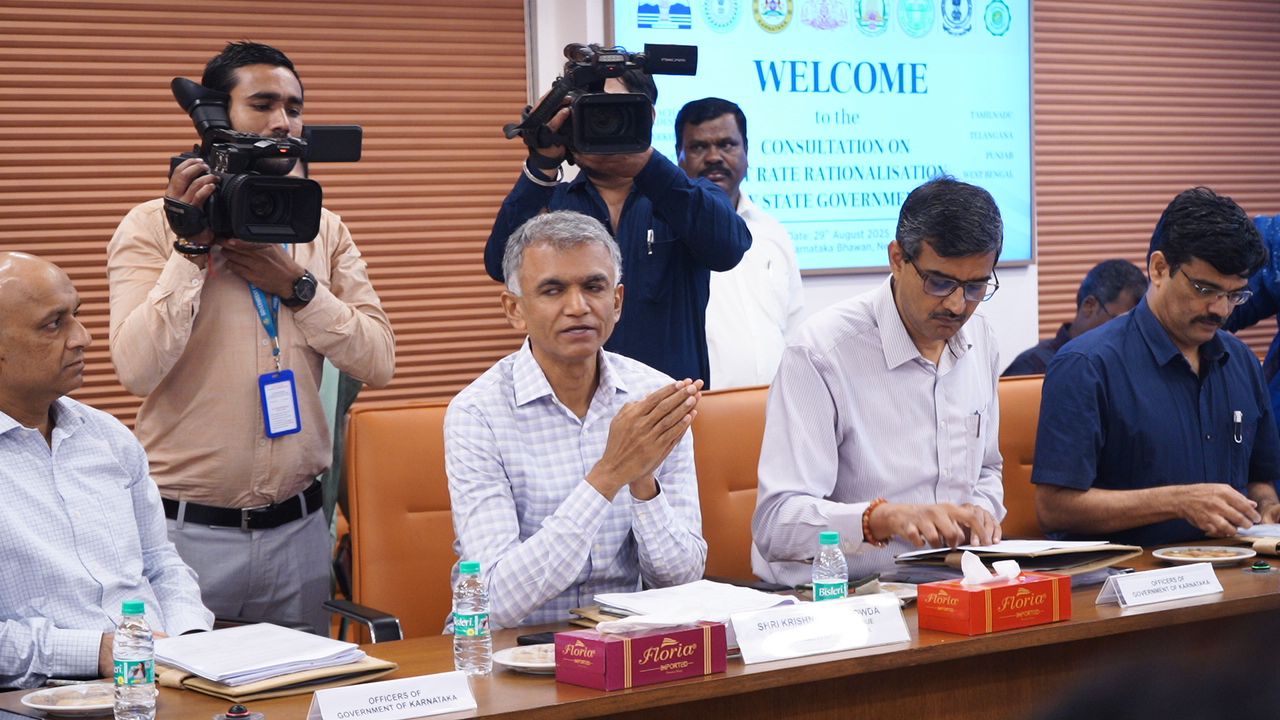For balancing rate rationalisation and revenue neutrality, the states suggested levying an additional duty — which should be distributed among states — on sin and luxury goods, over and above the proposed 40 percent rate.
Published Aug 29, 2025 | 4:12 PM ⚊ Updated Aug 29, 2025 | 4:12 PM

Karnataka Finance Minister Krishna Byra Gowda at the meeting in New Delhi on Friday, 29 August.
Synopsis: The states demanded that any new proposal for rate rationalisation must be tempered by a realistic assessment of the extent to which buoyancy can compensate for revenue losses. It should be accompanied by clear safeguards built into the GST framework to protect the fiscal interests of the states, given the very high likelihood of a substantial revenue shortfall post-rate rationalisation.
With five more days remaining for the 56th GST Council Meeting in New Delhi, finance ministers of eight non-NDA-ruled states have demanded fair compensation for revenue loss due to the Centre’s GST reform proposal.
The Opposition-ruled states — Himachal Pradesh, Jharkhand, Karnataka, Kerala, Punjab, Tamil Nadu, Telangana, and West Bengal — will present their proposals at the GST Council meeting scheduled for 3 and 4 September.
The finance ministers and representatives of these states, who met at the Karnataka Bhavan in New Delhi, noted that multiple rounds of rate rationalisation have been undertaken since the introduction of the GST in July 2017.
“The present proposal by the Union for rationalisation seeks to further simplify the rate structure by reducing the number of slabs and shifting many items to lower tax slabs,” they noted.
Such rationalisations have been premised on the expectation of significant medium- to long-term revenue gains, driven by efficiency improvements and higher consumption.
However, each round of rationalisation has hurt state revenues as the buoyancy expected to compensate for these revenue losses has not materialised. It is estimated that between FY18 and FY24, the net effective GST rate fell from 14.4 percent to 11.6 percent due to the rationalisation of rates.
Hence, the states demanded that any new proposal for rate rationalisation must be tempered by a realistic assessment of the extent to which buoyancy can compensate for revenue losses. It should be accompanied by clear safeguards built into the GST framework to protect the fiscal interests of the states, given the very high likelihood of a substantial revenue shortfall post-rate rationalisation.
For balancing rate rationalisation and revenue neutrality, the states suggested levying an additional duty — which should be distributed among states — on sin and luxury goods, over and above the proposed 40 percent rate, to maintain the current tax incidence.
On 21 August, a Group of Ministers meeting chaired by Union Finance Minister Nirmala Sitharaman proposed tax rates of 5 percent and 18 percent, with a special 40 percent rate suggested for five to seven items, including sin goods.
Currently, GST is applied at rates of 5 percent, 12 percent, 18 percent, and 28 percent. Essential items, such as food, are either exempt or taxed at 5 percent, while luxury and demerit goods fall under the 28 percent slab, with an additional cess.
If there is a deficit after the imposition of the proposed additional levy, the Union government should raise loans secured against the future receipts of the additional levy, as there is a successful precedent to such a mechanism, the states demanded.
Addressing the media after the meeting, Karnataka’s Finance Minister Krishna Byre Gowda said each state would lose 15-20 percent of its GST revenue, which would destabilise the fiscal structure of states.
He pointed out the decrease in net rate of taxation to 11 percent from the 14.4 percent revenue-neutral rate when the GST was implemented.
The Centre’s proposal to further reduce GST rates and cut down the number of slabs would further decrease the net rate of taxation to 10 percent, Gowda said.
The ministers who attended the meeting felt the states’ revenue interests must be protected to insulate people and development activities. Any reduction would affect the states’ autonomy.
Kerala’s Finance Minister KN Balagopal said all ministers and representatives who attended the meeting voiced serious concerns about the substantial revenue loss leading to disruption in social welfare programmes and developmental expenditures under the Union government’s current proposal.
He said the tax reduction should be passed over to the common people and should not result in profiteering.
Balagopal said the meeting discussed the draft proposal in length. “A consensus was reached that the draft proposal would be the minimum safeguard for the states’ revenue interests while achieving GST rate rationalisation,” he said.
The minister said all states that attended the meeting expressed willingness to work with the Centre and other state governments to ensure that the GST rate rationalisation exercise resulted in beneficial outcomes for all stakeholders.
